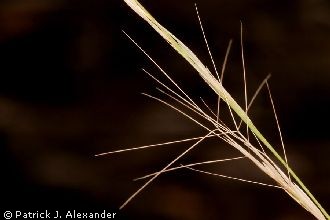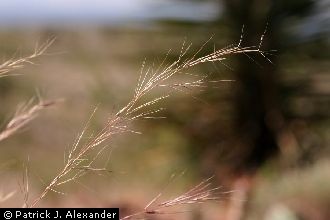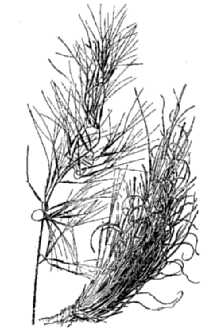Purple Threeawn
Scientific Name: Aristida purpurea Nutt.

| General Information | |
|---|---|
| Usda Symbol | ARPU9 |
| Group | Monocot |
| Life Cycle | AnnualPerennial, |
| Growth Habits | Graminoid |
| Native Locations | ARPU9 |
Plant Guide
Description
General: Purple threeawn is a slender densely cespitose perennial bunchgrass. Culms range from 9.5 to 35.5 inches (25 to 90 cm) tall. Leaves are mostly basal with blades 1.0 to 9.5 inches (3.0 to 25 cm) in length, 0.03 to 0.08 inches (0.07-0.2 cm) wide, typically involute, but the bases remain flat. Inflorescences usually contain a sparingly branched panicle. Glumes are unequal with the lower glume shorter than the upper and are light to dark brown or purple in color. Awns range from 2.4 to 5.5 inches (6.0 to14 cm) in length with the central awn being thicker than the lateral awns. Caryopses are about 0.24 to 0.55 inches (0.66 to 1.4 cm) long, tan to chestnut in color. Distribution: Purple threeawn is widespread across its native habitat in western North America, extending from Canada into Mexico, and is found on a wide variety of soils (Barkworth et al. 2007). For current distribution, please consult the Plant Profile page for this species on the PLANTS Web site. Habitat: Purple threeawn is commonly found on dry plains with gravelly or sandy soils; however, it occasionally occurs on clay soils as well (Hatch and Pluhar 1993). This colonizer species is often associated with sand dropseed [(Sporobolus virginicus (L.) Kunth] and grama (Boutelous spp.) species.
Adaptation
Purple threeawn is adapted to dry, recently disturbed sites. It is also capable of thriving in areas that have been heavily grazed.
Uses
Purple threeawn is recommended for critical site revegetation, erosion control, and rights-of-way plantings due to its fibrous root system, ability to establish and persist in low moisture situations, and abundant seed production making it a pioneer species following disturbance (Loflin and Loflin 2006). It is useful in seed mixes and adapted to most soil types. Although listed as poor forage, purple threeawn is often utilized by cattle prior to seed development (Everitt et al 2011) and as a nesting substrate for bobwhite quail (Lehmann 1946).
Status
Please consult with your local NRCS Field Office, Cooperative Extension Service office, state natural resource, or state agriculture department regarding its status and use. Please consult the PLANTS Web site and your State Department of Natural Resources for this plant’s current status (e.g., threatened or endangered species, state noxious status, and wetland indicator values).
Planting Guidelines
Begin seedbed preparation well in advance of planting. Establish a clean, weed-free seedbed by either tillage or herbicides. Prior to planting, the site should be firm and have accumulated soil moisture. Purple threeawn is seeded at a rate of 0.5-1 pounds pure live seed (PLS) per acre using a drill or broadcast seeder. If broadcast seeded, some type of additional coverage such as cultipacking or light dragging is recommended to ensure good seed-to-soil contact. Plant seed to ¼ inch deep. It is better to plant too shallow than too deep. Purple threeawn contains approximately 4,813,240 seeds per pound (Barkworth et al. 2007 and Shaw 2012).
Management
Avoid grazing of new plantings for 90 days to allow plants to become established. Purple threeawn readily reseeds itself with minimal soil disturbance. Allow plants to produce seed annually to maintain stand health.
Pests and Potential Problems
There are no potential problems or pests associated with purple threeawn.
Environmental Concerns
Concerns , Use soil moisture sensors to measure the soil moisture of Purple Threeawn.
Concerns
There are no environmental concerns associated with purple threeawn.
Control
Please contact your local agriculture extension agent or extension weed specialist to learn what herbicides work best for weed control in your area and how to use it safely. Always read label and safety instructions for each control method.
Seeds and Plant Production
Plant Production
Plant Production
Purple threeawn is best started using greenhouse grown transplants and planted into bedded rows. Seedlings grow and mature quickly and produce a marketable crop in the year of planting. Seed harvest is possible using a variety of methods and implements. Because seed ripens indeterminately, a Flail-Vac harvester collects the ripe seed crop without damaging or eliminating the ability to make subsequent harvests as later flowering florets mature. In well managed, irrigated fields, 2-3 harvests are possible per year. The first harvest is typically in May, with the last harvest in October. Potential seed yields per acre is 10 PLS pounds on 36-inch bedded rows with a plant population of 14,000 plants per acre. Cultivars, Improved, and Selected Materials (and area of origin) Menard Germplasm purple threeawn was cooperatively released in 2020 by the U.S. Department of Agriculture (USDA), Natural Resources Conservation Service (NRCS), James E. “Bud” Smith Plant Materials Center, Knox City, Texas; Texas Natives Seeds, Caesar Kleberg Wildlife Research Institute, Texas A&M University-Kingsville, Kingsville, Texas; Sul Ross State University, Borderlands Research Institute, Alpine, Texas; Texas AgriLife Research, Stephenville, Texas. It is recommended for critical site revegetation, roadside plantings, erosion control, wildlife plantings and inclusion in range seedings mixes in the Rio Grande Plains, Gulf Coast Prairies and Marshes, Edwards Plateau, Rolling Plains, Cross Timbers, and Blackland Prairies ecoregions of Texas. Loma Germplasm purple threeawn was collaboratively released in 2021 by Texas Native Seeds, the USDA NRCS E. “Kika” de la Garza Plant Material Center in Kingsville, Texas, Sul Ross State University Borderlands Research Institute in Alpine Texas, and Texas A&M AgriLife Research Center in Stephenville, Texas. This release is made of one collection originating from the Coastal Sand Plain of Texas. Loma Germplasm is recommended for use in range seeding mixes, critical site revegetation, and rights-of-way plantings in south Texas. Generation 0 seed is maintained by Texas Native Seeds. Cultivars are selected based on the local climate, resistance to local pests, and intended use. Consult with your local land grant university, local extension or local USDA NRCS office for recommendations on adapted cultivars for use in your area.
Literature Cited
Barkworth, M.E., L.K. Anderton, K.M. Capels, S. Long, and M.B. Piep. 2007. Manual of Grasses for North America. Utah State University Press. Logan, Utah. Everitt, J.H., D.L. Drawe, C.R. Little, and R.I. Lonard. 2011. Grasses of South Texas. Texas Tech University Press. Lubbock, Texas. Hatch, S.L. and J. Pluhar. 1993. Texas Range Plants. Texas A&M University Press. College Station, Texas. Lehmann, V.W. 1946. Bobwhite Quail Reproduction in Southwestern Texas. The Journal of Wildlife Management. 111-123. Loflin, B. and S. Loflin. 2006. Grasses of the Texas Hill Country. Texas A&M University Press. College Station, Texas. Shaw, R.B. 2012. Guide to Texas Grasses. Texas A&M University Press. College Station, Texas. Citation Falk, A., C.B. Carr, and D.R. Wiggans. 2020. Plant Guide for purple threeawn (Aristida purpurea Nutt.). USDA-Natural Resources Conservation Service, James E. “Bud” Smith Plant Materials Center. Knox City, Texas, 79529. Published September 2020 Edited: 26Oct2021 sdm For more information about this and other plants, please contact your local NRCS field office or Conservation District at http://www.nrcs.usda.gov/ and visit the PLANTS Web site at http://plants.usda.gov/ or the Plant Materials Program web site: http://plant-materials.nrcs.usda.gov. PLANTS is not responsible for the content or availability of other Web sites. In accordance with Federal civil rights law and U.S. Department of Agriculture (USDA) civil rights regulations and policies, the USDA, its Agencies, offices, and employees, and institutions participating in or administering USDA programs are prohibited from discriminating based on race, color, national origin, religion, sex, gender identity (including gender expression), sexual orientation, disability, age, marital status, family/parental status, income derived from a public assistance program, political beliefs, or reprisal or retaliation for prior civil rights activity, in any program or activity conducted or funded by USDA (not all bases apply to all programs). Remedies and complaint filing deadlines vary by program or incident. Persons with disabilities who require alternative means of communication for program information (e.g., Braille, large print, audiotape, American Sign Language, etc.) should contact the responsible Agency or USDA's TARGET Center at (202) 720-2600 (voice and TTY) or contact USDA through the Federal Relay Service at (800) 877-8339. Additionally, program information may be made available in languages other than English. To file a program discrimination complaint, complete the USDA Program Discrimination Complaint Form, AD-3027, found online at How to File a Program Discrimination Complaint and at any USDA office or write a letter addressed to USDA and provide in the letter all of the information requested in the form. To request a copy of the complaint form, call (866) 632-9992. Submit your completed form or letter to USDA by: (1) mail: U.S. Department of Agriculture, Office of the Assistant Secretary for Civil Rights, 1400 Independence Avenue, SW, Washington, D.C. 20250-9410; (2) fax: (202) 690-7442; or (3) email: program.intake@usda.gov. USDA is an equal opportunity provider, employer, and lender.


